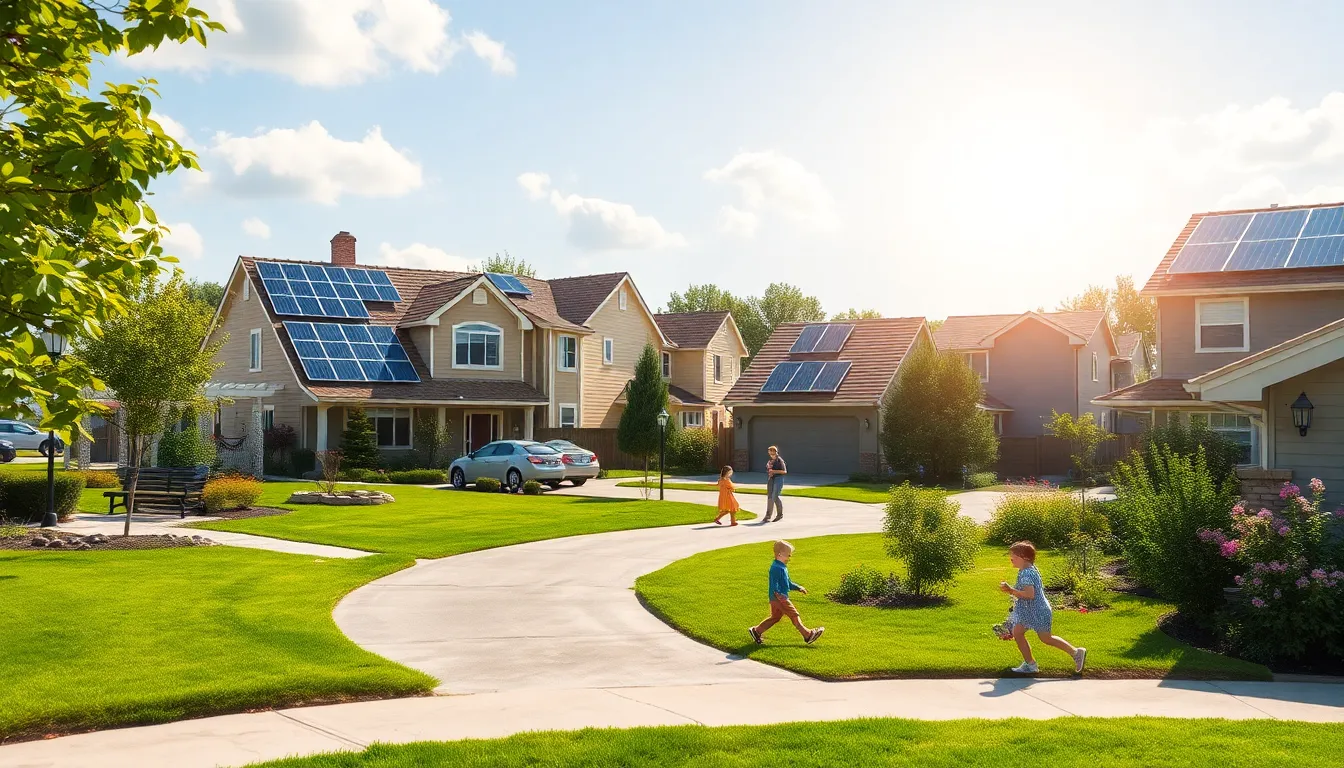Picture this: you’re sipping coffee on your sun-soaked patio, basking in the glow of your solar-powered home. Sounds dreamy, right? Welcome to the world of solar smart living, where sustainability meets savvy technology. It’s not just about saving the planet; it’s about saving your wallet too.
In a time when energy bills can feel like a bad joke, solar smart living offers a punchline that’s both eco-friendly and budget-friendly. With innovative solutions that harness the sun’s power, this lifestyle transforms homes into energy-efficient havens. So why not swap those hefty utility bills for a brighter, greener future? Embrace the sun and discover how solar smart living can turn your home into a shining example of modern sustainability.
Table of Contents
ToggleOverview of Solar Smart Living
Solar smart living embodies a lifestyle centered on harnessing solar energy. It entails integrating solar technologies in everyday life, promoting sustainability while enhancing energy efficiency. Individuals can significantly lower electricity bills by utilizing solar panels for power generation.
Implementing smart home technologies complements solar systems. These systems often include energy-efficient appliances and smart thermostats that manage energy consumption effectively. Together, they create a harmonious balance between energy production and utilization.
Adopting solar smart living positively impacts the environment. Solar energy reduces reliance on fossil fuels, leading to lower carbon emissions. This shift encourages cleaner air and a healthier planet for future generations.
Solar incentives and rebates enhance the appeal of transitioning to solar energy. In many regions, government programs offer financial support for installations. These savings can offset initial project costs, making solar technology more accessible.
Communities embracing solar smart living often experience a boost in local economies. Job creation in the solar sector increases, providing new employment opportunities. Furthermore, energy independence fosters resilience against fluctuating energy prices.
Solar smart living presents a feasible solution for individuals striving for an eco-conscious lifestyle. The combination of solar technology and energy management creates not only savings but also a sustainable future. Adopting these practices aids in shaping a cleaner, greener world for all.
Benefits of Solar Smart Living

Solar smart living offers numerous advantages that extend beyond individual lifestyle changes. This approach integrates renewable energy solutions, fostering environmental health and economic stability.
Environmental Impact
Solar energy significantly reduces greenhouse gas emissions. Transitioning to solar power lessens reliance on fossil fuels, which is pivotal for combating climate change. Communities embracing solar solutions often experience improved air quality. Cleaner air contributes to better health outcomes for residents. Wildlife habitats benefit from reduced pollution, promoting biodiversity. Additionally, solar energy systems utilize minimal land compared to traditional energy sources, preserving natural ecosystems. By prioritizing solar technologies, individuals contribute to a more sustainable future for the planet.
Economic Advantages
Economic benefits accompany the shift to solar energy. Homeowners frequently enjoy lower electricity bills, resulting in immediate savings. Government incentives, such as tax credits and rebates, alleviate initial costs associated with solar installations. These financial aids make solar more accessible, encouraging broader adoption. Job creation in the solar sector also stimulates local economies. Jobs range from manufacturing to installation, supporting community growth. Energy independence leads to greater control over utility costs. This independence insulates homeowners from fluctuating energy prices, maximizing long-term savings.
Key Components of Solar Smart Living
Solar smart living integrates innovative technologies to promote energy efficiency and sustainability. Essential components contribute to creating a lifestyle that significantly benefits both the individual and the environment.
Solar Panels
Solar panels serve as the foundation of solar smart living. These devices convert sunlight into electricity, providing homeowners with a renewable energy source. Savings start immediately, as energy bills drop due to reduced reliance on utility power. Efficiency levels continue to improve with advancements in solar technology, allowing panels to generate more energy with less sunlight. Long-term investment in solar panels often pays off, with many systems having lifespans over 25 years. Financial incentives available at state and federal levels further encourage adoption, making solar panels an attractive option for eco-conscious households.
Smart Home Technologies
Smart home technologies enhance the efficiency of solar smart living. Devices like smart thermostats optimize heating and cooling systems, reducing energy consumption when it’s not needed. Energy-efficient appliances are designed to use less power while maintaining performance, which results in further savings. Smart meters provide real-time energy usage data, enabling homeowners to adjust their consumption patterns effectively. Integrating these technologies with solar systems maximizes energy utilization, ensuring homeowners get the most from their investments. Overall, the combination of smart technologies with solar energy creates a seamless and efficient living experience.
Implementation Strategies
Implementing solar smart living involves careful planning and strategic execution. Successful integration of solar technologies and smart home systems can lead to significant energy savings and enhanced sustainability.
Initial Setup
Initial setup of a solar energy system starts with conducting an energy audit, identifying areas for improvement, and evaluating energy consumption patterns. Selecting high-quality solar panels is crucial for maximizing sunlight conversion efficiency. Installation by certified professionals ensures compliance with safety standards and optimal performance. Many homeowners utilize net metering to offset excess energy produced by solar panels. Local incentives or rebates can help alleviate upfront costs, making solar power more accessible.
Maintenance and Upgrades
Maintaining a solar system involves routine inspections, cleaning the panels, and monitoring performance to ensure longevity. Checking for shading caused by overgrown trees can help maintain energy production. Upgrades focus on enhancing system efficiency and integrating new technologies. Adding energy storage solutions can provide homeowners with backup power during outages or high-demand periods. Monitoring software offers real-time data, allowing users to track energy usage and savings effectively. Keeping the system up-to-date maximizes both efficiency and sustainability.
Challenges and Considerations
Implementing solar smart living presents various challenges that individuals need to navigate. Initial installation costs for solar panels and smart home technologies often pose a significant barrier. While financial incentives and rebates mitigate these expenses, upfront investments can still require careful budgeting.
Space limitations in urban environments impact the installation of solar panels. Homeowners in densely populated areas might face obstacles in maximizing solar energy generation. Assessing roof orientation and shading from nearby structures is essential for optimal performance.
Maintenance requirements also deserve attention. Solar systems demand routine inspections to detect any performance issues, ensuring long-term efficiency. Understanding maintenance processes helps homeowners sustain their investments over time.
Regulatory considerations factor into the adoption of solar technology. Local laws may impose restrictions on installations or the use of solar energy, making it imperative to research applicable regulations. Consulting with local authorities assists in complying with these requirements.
Integration of smart home technologies adds complexity. Familiarizing oneself with various platforms and devices is necessary for effective smart home management. Choosing products that are compatible with each other enhances the overall user experience.
Despite these challenges, the long-term benefits of solar smart living outweigh the initial hurdles. Individuals who navigate these considerations can enjoy lower energy bills and contribute to a greener environment. Educating oneself about available resources and potential pitfalls reinforces a successful transition to solar-supported lifestyles.
Embracing solar smart living offers a transformative path toward sustainability and financial savings. By integrating solar energy and smart home technologies, individuals can significantly enhance their energy efficiency while contributing to a healthier planet. The initial challenges associated with installation and maintenance are outweighed by the long-term benefits of reduced energy costs and a smaller carbon footprint.
As communities increasingly adopt this lifestyle, they not only enjoy economic advantages but also foster a collective movement toward greener living. With financial incentives making solar solutions more accessible, now’s the perfect time for homeowners to explore the potential of solar smart living. This approach not only benefits personal finances but also plays a vital role in creating a sustainable future for everyone.



